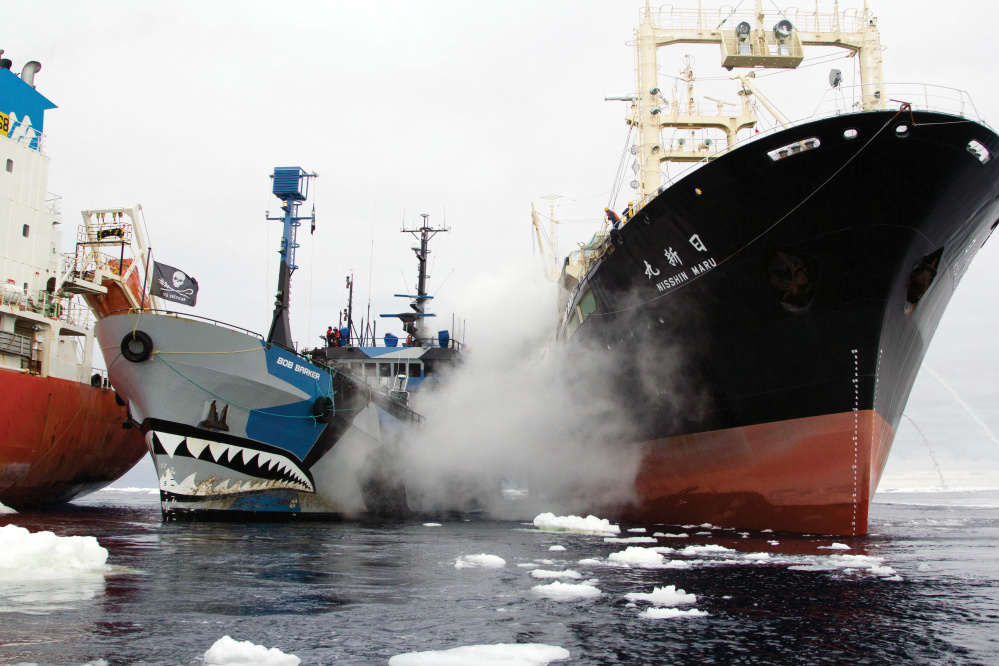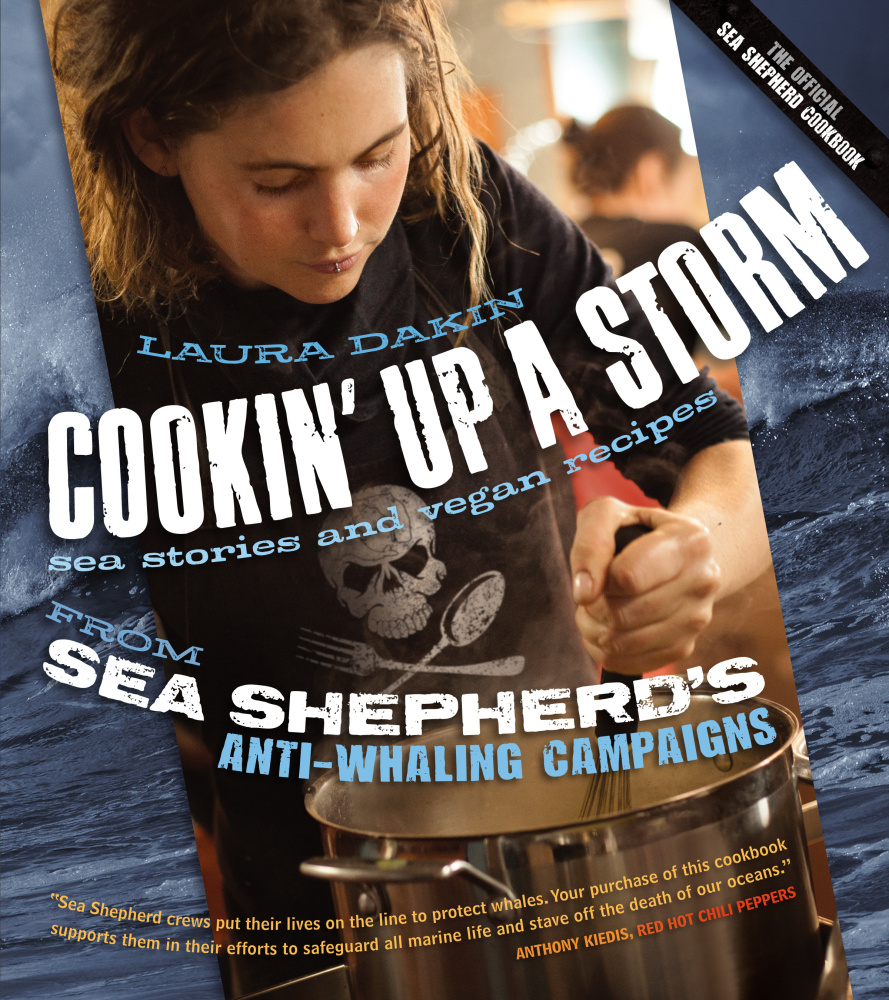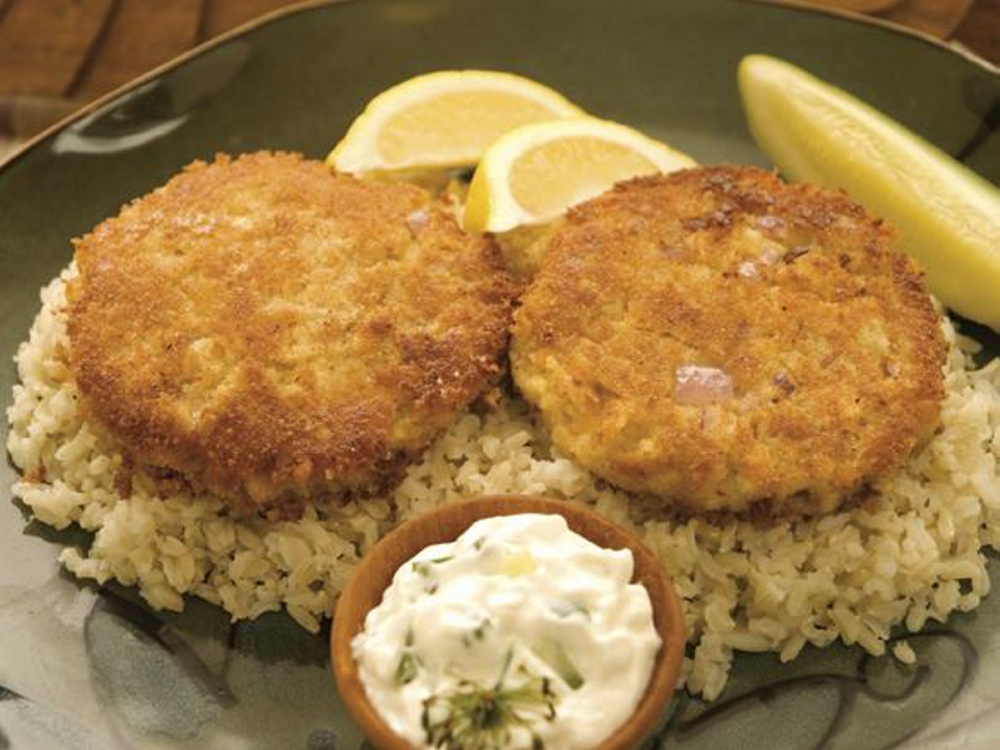The next time I’m struggling to get dinner on the table, I’ll be grateful I’m not on the high seas.
In the full-color cookbook “Cookin’ Up A Storm: Sea Stories and Vegan Recipes” from the Sea Shepherd Conservation Society, which was published last February, Laura Dakin writes about the challenges of feeding a crew of 50 while on voyages lasting up to 100 days.
In a particularly gripping essay, Dakin, now 31, writes about preparing dinner with the rest of the galley crew as the vessel tosses back and forth, causing the portholes to go under water “every few seconds.”
During this stage of the storm – after two batches of tahini dressing have been spilled and the pie took three hours to make – “simply being in the galley is dangerous. The floor inevitably gets wet and becomes slippery. For quite a while, all you can do is hang on, taking care that you don’t fall over, get stabbed by a knife, or get burned by a scalding pot or a red-hot oven.”
Yet storms aren’t the only high-intensity times for the kitchen crews working on Sea Shepherd’s fleet of boats, which roam the world’s oceans in search of whalers. When they find these ships, Sea Shepherd crew members work to disrupt the slaughter.
The command “Action stations!” rings out, and every crew member heads to a battle station. The galley crew springs to work preparing snacks and heating up drinks, which will be much appreciated by the members of the crew stationed on deck with water cannons or in inflatable boats to get between the whalers and their prey. Dakin adds that if anyone is hurt during a confrontation, “It falls to us to provide the necessary medical environment.”
Dakin has been with Sea Shepherd since 2005, working on the Farley Mowat and Steve Irwin ships, traveling the globe in search of factory-style fishing boats.
In the fight to stop poachers, few take as bold a stance as this environmental group, which often courts controversy and some have criticized as too aggressive.
Sea Shepherd was organized in 1977 by Paul Watson, a founder of Greenpeace who later had a falling out with that organization. The group is known for ramming the boats of illegal fishing fleets, spraying them with high-powered water cannons and otherwise disrupting their attempts to slaughter animals.
Less well known (until now) is the food coming out of the ships’ galleys, which have always been vegetarian and became vegan in 2006.
“When I took charge of the galley I was very firm on my position to cook only vegan meals,” Dakin told me via email from her home in Coolum on Australia’s Sunshine Coast. She added that the switch happened because of the “other passionate vegans on board, and Paul Watson’s compassion and drive to move forward in a positive direction with the organization.”
Dakin includes an interview with Watson in the book, where he explains why the organization has always served only vegetarian food.
“What most people don’t realize, however,” Watson writes, “is that meat eating also greatly diminishes the oceans, because 40 percent of the fish taken from the sea is fed to pigs, chickens, cows, domestic cats and farm-raised fish. In fact, pigs are eating more fish than sharks, chickens are eating more fish than puffins, and cats are eating more fish than seals. So really, when you eat bacon you’re eating the sea.”
Instead of fish, the cookbook dishes up plenty of recipes with seafaring flavors and names, such as Southern Ocean Scramble, Clear Skies Cleansing Soup, First Mate’s Mushroom and Kale Sauté, Taste-of-the-Sea Spaghetti, Old Salt (and Pepper) Tofu, Sailor’s Delight Sausages and, of course, Fish-Free Cakes (see recipe).
The book’s breakfast section includes savory dishes – such as beans and stewed tomatoes – because as Dakin points out, the 24/7 nature of a ship means “breakfast is always somebody’s lunch or dinner.”
Watson contributes the recipe for Captain’s Habitat Split Pea Soup, which he enjoyed while growing up in New Brunswick. Since the galley crew makes its own bread, a chapter is devoted to the basics, including a white loaf, a naan, a Swedish flatbread and dinner rolls.
Angela May Bell, a Portland resident who holds regular fundraisers for the Sea Shepherd Conservation Society, is a big fan of the new cookbook. She first learned about the organization in a magazine write-up about the all-vegetarian galleys on the ships.
“As an onshore volunteer, the cookbook connects me to the offshore volunteers through the fun stories and great recipes,” said Bell, whose fundraising work for the group is chronicled on Facebook at facebook.com/fortheoceans.
Sprinkled among the book’s recipes are short accounts from fellow crew members. In one such account, Chad Halstead writes of putting on a dry suit and heading out from the ship Steve Irwin in a small craft to take direct action against a fleet of whaling ships.
“As we approach,” Halstead writes, “I see the crews running frantically on the decks of the harpoon ships, pulling protective nets and anti-boarding spikes along the sides. They start up their water cannons in hopes of fending us off.” For a moment, he writes, the world “stands still” as the huge whaling ship looms overhead and Halstead realizes “in a world of seven billion people, my crewmates and I are the only ones here to fight this battle.”
The good news is the organization’s campaigns seem to be working.
Dakin told me: “We’ve always returned to Australia for annual anti-whaling campaigns, but in 2014 the International Court of Justice ruled that Japan’s whaling program in Antarctica is illegal, and the hunt is currently suspended.”
This has freed up Sea Shepherd ships for other campaigns.
I asked Dakin how her family reacts when she’s campaigning with Sea Shepherd, and she admits they don’t “love it.”
“We are often campaigning in fairly dangerous parts of the world,” Dakin told me, “from the ice floes off the Northeast coast of Canada down to the very bottommost point a ship can venture in the Antarctic Southern Ocean. Not only that, but we are then engaging in heavy and often aggressive anti-poaching actions.”
However, Dakin will be on dry land for the next few years. She recently gave birth to a son, and says “I am sure I will voyage again someday, but for the immediate future I will have to leave that side of life to my partner Mal Holland, who is a Sea Shepherd captain.” (And provides one of the book’s firsthand accounts.)
With a new baby and the inevitable sleepless nights, Dakin did have some preparation for her new routine on the ship, where the galley crew begins each day at 6 a.m.
“The galley day ends when the galley is clean and everything is tied down for the evening,” Dakin told me. “That way you can sleep easy, knowing that if a storm strikes in the night, you won’t be waking into a midnight explosion. Dinner is served at 6 p.m., so we knock off any time after that depending on what kinda crazy mess we have made.”
She then added: “Of course, when it’s time for action, we all do whatever needs to be done, any time of the day or night.”
Sounds like parenthood – minus the tossing ship.
Avery Yale Kamila is a freelance food writer who lives in Portland. She can be contacted at:
avery.kamila@gmail.com
Twitter: AveryYaleKamila
Fish-free Cakes
The best thing about these fish cakes from “Cookin’ Up A Storm” is, of course, that they’re not made of fish. The addition of nori, a type of seaweed, and vegan fish sauce gives them the taste of the ocean. You can find vegan fish sauce at health food stores.
Makes 8 fish-free cakes
1 sheet nori, cut into thin, short strips
1¾ cups (435 ml) no-salt-added cooked or canned chickpeas, rinsed, drained and finely chopped
¼ cup (60 ml) vegetable oil, plus more for the skillet
1 medium potato, peeled, cooked and mashed
3 ounces (85 g) firm tofu, mashed
¼ red onion, minced
2 tablespoons (30 ml) vegan fish sauce
1 tablespoon (15 ml) tapioca starch or potato starch, plus more as needed
1 tablespoon (15 ml) nutritional yeast flakes
1 teaspoon (5 ml) salt
1 cup (250 ml) bread crumbs or potato flour
Put the nori in a large bowl. Add the chickpeas and oil and stir until well combined.
(The oil will help prevent the nori from clumping, which it tends to do when wet.) Add the potato, tofu, onion, fish sauce, tapioca starch, nutritional yeast and salt and mix with your hands until well combined.
The mixture should be cohesive enough to form firm patties. If the mixture doesn’t hold together, add up to 1 tablespoon (15 ml) of additional starch, 1 teaspoon (5 ml) at a time until it does.
Put the bread crumbs on a large plate. Divide the chickpea mixture into equal portions and press each into a small patty using your hands. Press both sides of each patty into the bread crumbs and transfer to a large plate.
Line a large plate with paper towels. Oil a large skillet and heat over medium heat. Carefully put the fish cakes in the skillet; the oil may splatter, so take care. Cook on each side until deep golden brown, about 7 minutes per side. Transfer to the lined plate to remove any excess oil. You may need to cook the patties in 2 or 3 batches, depending on the size of your skillet.
Serving suggestion: These patties can be served sandwich style or on a plate with a side of brown rice. Either way, they’re great accented with a squeeze of fresh lemon or with vegan tartar sauce.
Send questions/comments to the editors.




